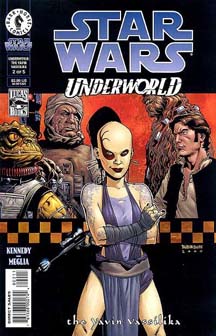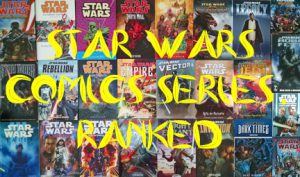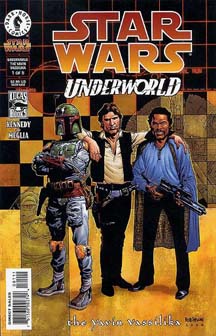“Rebels,” set between Episodes III and IV, will premiere on Oct. 3 on the Disney Channel, but as fans know, for many years there was another TV series planned for this era: “Underworld.” This live-action series hasn’t been talked about lately, so it’s safe to assume it went the way of the later seasons of “The Clone Wars,” the 3-D movie re-releases and the Expanded Universe: Something that doesn’t fit into Disney’s vision for “Star Wars.”
Still, there was a five-issue comic book series called “Underworld: The Yavin Vassilika” (2000-01). The name is coincidental, but naturally, it does explore the underworld between Episodes III and IV. More specifically, “Underworld” takes place about 90 percent of the way through “Rebel Dawn,” the final book of A.C. Crispin’s “Han Solo Trilogy” – after the big battle but before the epilogue that links up directly with Han’s debut in “A New Hope.”
“Underworld” references the Ylesian raid in which Rebel Bria Tharen makes an enemy of her former boyfriend Han, and Han in turn makes enemies of the smuggling community, notably Lando. As with Timothy Zahn’s novel “Scoundrels,” set between Episodes IV and V, it’s somewhat odd that Han and Lando are on generally friendly terms in “Underworld,” as it seems like Crispin intended the friends’ rift in “Rebel Dawn” to carry directly into “The Empire Strikes Back.” Still, as per my policy on questionable continuity, I’ll allow it if the story is good, and “Underworld” is darn good.

Mike Kennedy pens the biggest and possibly best bounty hunter romp in “Star Wars” lore. It starts with three Hutts – Jabba, Embra and Malta — making a bet among themselves to see who can acquire an idol called the Yavin Vassilika. The contractors are Han, Chewie, Lando, Dengar, Bossk, IG-88, Zuckuss, 4-LOM, Boba Fett, Greedo, a new bounty hunter named Sardu Sallowe, Embra’s human handmaiden Jozzel Moffet and Malta’s Bith handmaiden Farqua. The quest plays out across various planets of Wild Space.
Despite all the rivalries and double-crossing, Kennedy’s plot is clear, and there’s a fun rhythm to his dialogue, like when Dengar calls IG-88 “G.” Kennedy clearly read “Rebel Dawn” in preparation for this story and also knows the characters well. Take, for example, this gem in Issue 2 from our favorite dashing rogue:
Lando: “Do we know each other?”
Jozzel: “Not yet.”
Lando (going in for the hand kiss): “Thank goodness. For a moment there, I was afraid I might have lost track of some priceless memories.”
Carlos Meglia’s quirky pencils and inks (paired with Dave Stewart’s colors) do a lot of storytelling, too. A prime example is Greedo tagging along in the background of Han’s group, looking sheepish and hardly being mentioned at all by the grown-ups in the group. “Underworld” takes longer to read than most five-issue series, partly because it’s dialogue-heavy, but mainly because there’s so much detail in each panel that adds to the story and characters. A reader gets their money’s worth.

I quibble slightly with how “Underworld” wraps up. Jozzel is a sexy, scheming breakthrough character in the early issues and I expected a punchline showing how everything falls into place for her in the end. As it turns out, though, Boba Fett gets the last laugh, as is almost always the case when he appears in a Dark Horse comic. “Underworld” arguably has too many twists and turns, although it is neat to see Han’s ex Bria in comic-book form for the first (and only) time in Issue 5, and I suppose there’s something to be said for a story where the outcome is unpredictable.
Despite the same names being a coincidence, “Underworld: The Yavin Vassilika” is a strong example of how to tell side stories about fan-favorite characters that don’t contradict the main narrative flow of the galactic conflict. The TV series “Underworld” presumably would’ve done something like that, too.
Speaking of paths not taken, this turned out to be the only collaboration between Kennedy and Meglia – whose combined efforts are greater than their individual work, although Kennedy also wrote “Qui-Gon and Obi-Wan: The Aurrorient Express” and Meglia did the art for “Lando’s Commandos” in “Star Wars Tales” Issue 5.

